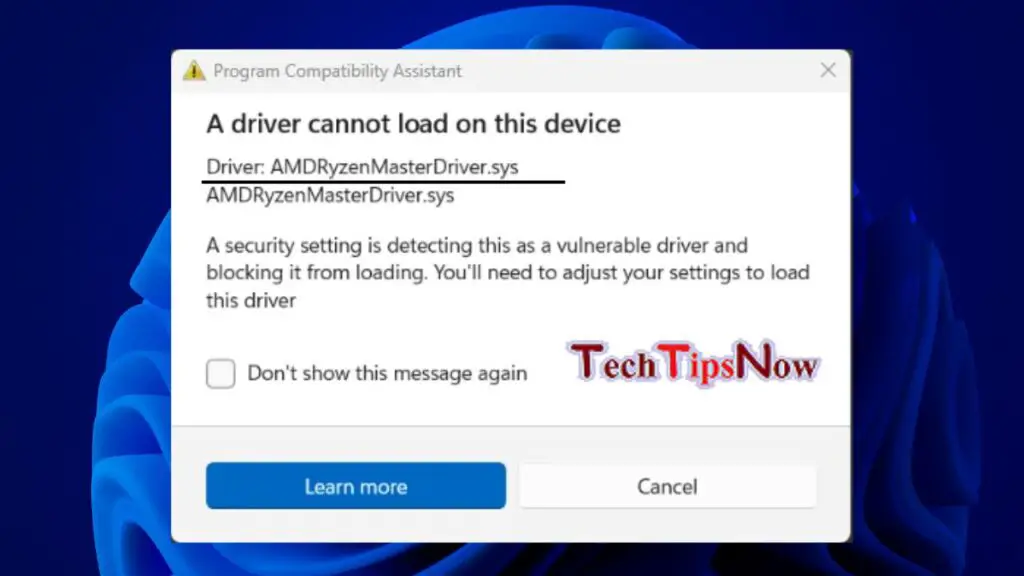If you’re a PC hardware enthusiast or a power user running an AMD Ryzen CPU, chances are you’ve used AMD Ryzen Master—AMD’s official overclocking and performance tuning utility. But if you’ve recently been greeted by the error:
“AMDRyzenMasterDriver.sys cannot load on this device”
You’re not alone. Many users have started encountering this issue, especially after recent Windows updates. Let’s dig into why this is happening—and more importantly, how you can fix it.

What Is AMDRyzenMasterDriver.sys?
AMDRyzenMasterDriver.sys is a system driver that allows the Ryzen Master software to interface directly with the CPU. It enables voltage/frequency adjustments, core activation/deactivation, temperature monitoring, and more.
But if this driver is blocked, the Ryzen Master utility won’t function as intended—if at all.
Why Windows Is Blocking the Driver
With the rollout of Memory Integrity (a.k.a. Hypervisor-Protected Code Integrity or HVCI) in Windows 11 and late-stage Windows 10, Microsoft has tightened driver validation rules to improve system security.
Now, any driver that:
- Is unsigned, or
- Uses deprecated signing methods, or
- Is flagged as vulnerable or outdated
…gets blocked at boot time.
AMDRyzenMasterDriver.sys—especially older versions—can fall into this category.
How to Fix “AMDRyzenMasterDriver.sys Cannot Load on This Device”
Here are four proven solutions to resolve the issue, starting from the safest to more advanced options.
Check for Optional Windows Updates
Sometimes Windows will offer updated driver packages through Optional Updates, especially for chipsets and hardware utilities.
Steps:
- Go to Settings > Windows Update.
- Click Advanced options > Optional updates.
- Look for any AMD-related drivers or updates.
- Install and reboot.
This might automatically update Ryzen Master or allow the driver to load with improved compatibility.
Update AMD Ryzen Master to the Latest Version
If you’re using an older version of Ryzen Master, it’s very likely incompatible with current security enforcement in Windows. AMD regularly releases updates that support newer Windows features.
Steps:
- Go to the official AMD Ryzen Master download page.
- Download the latest version.
- Run the installer to update in place.
- Reboot your PC.
Once updated, the newer driver should be digitally signed and compliant with Windows’ HVCI requirements.
Temporarily Disable Memory Integrity
If you need Ryzen Master to run and you’re comfortable with a slight trade-off in security, disabling Memory Integrity is an option.
⚠️ Warning: This reduces kernel-level protection from malicious drivers. Only proceed if you’re aware of the risks.
Steps:
- Open Windows Security (search in Start).
- Go to Device Security > Core isolation.
- Under Memory integrity, toggle the switch Off.
- Restart your PC.
Ryzen Master should now load successfully. You can choose to re-enable Memory Integrity afterward, although it may re-trigger the block.
Uninstall and Reinstall Ryzen Master
Sometimes residual files or broken permissions cause persistent issues even with updates.
Steps:
- Uninstall Ryzen Master via Control Panel > Programs and Features.
- Reboot your system.
- Download the latest version from AMD’s website.
- Reinstall it fresh.
- Check again if the driver loads.
This ensures that the latest driver and all dependencies are cleanly re-registered.
Final Thoughts
Windows’ push toward better driver security is great for end-user protection—but it occasionally locks out legit tools like Ryzen Master, especially if they haven’t been updated for the latest standards.
Here’s a quick summary of your options:
| Fix | Use When… |
| Check for Optional Updates | You’re unsure if Windows has the latest driver |
| Update Ryzen Master | You’re running an old version of the software |
| Disable Memory Integrity | You urgently need Ryzen Master and accept the risk |
| Reinstall Ryzen Master | The software seems corrupted or broken |
If none of these work, it’s worth checking AMD’s support forums or contacting their support directly. They may provide beta drivers or updated certificates ahead of official releases.